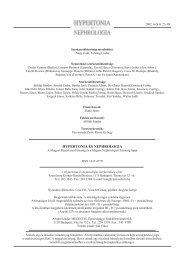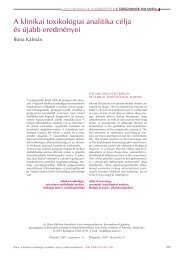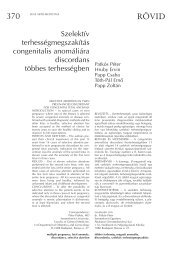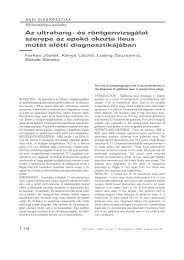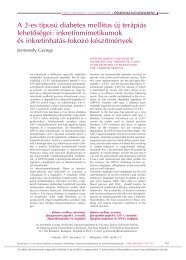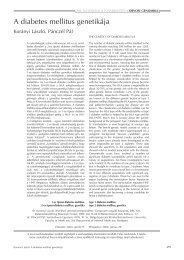HYPERTONIA ÉS NEPHROLOGIA - eLitMed.hu
HYPERTONIA ÉS NEPHROLOGIA - eLitMed.hu
HYPERTONIA ÉS NEPHROLOGIA - eLitMed.hu
You also want an ePaper? Increase the reach of your titles
YUMPU automatically turns print PDFs into web optimized ePapers that Google loves.
2002; 6 (1):3–15. ONTOGENY OF POTASSIUM TRANSPORT IN THE DISTAL NEPHRON 9<br />
and density of conducting apical K + channels in principal cells<br />
(19).<br />
The predominant K + permeable channel in cell-attached<br />
patches of the apical membrane of the principal cell is a<br />
low-conductance (30-40 pS) inwardly-rectifying ATP-sensitive<br />
secretory K + (SK) channel (1; 18; 44; 45). The prevalence<br />
of this channel and its high Po at the resting membrane<br />
potential suggests that this channel most likely mediates K +<br />
secretion under baseline conditions. Patch clamp analysis of<br />
maturing rabbit principal cells identified an increase in the<br />
mean number of conducting stock channels per patch after the<br />
second week of life (Fig. 5) (19), approximately one week<br />
after an increase in activity of the amiloride-sensitive Na +<br />
channel (ENaC) was identified (Fig. 5) (26). Conducting<br />
apical stock channels were not detected in CCDs isolated from<br />
animals in the first week of postnatal life. The increase in<br />
number of conducting channels appeared to be due primarily<br />
to a developmental increase in number of channels in each<br />
cell-attached patch (19). Although the possibility of an early<br />
increase in Po of existing channels could not be excluded, the<br />
Po of the SK channel did not change between 3 and 5 weeks of<br />
age, a time interval during which the number of conducting<br />
channels increased almost 3-fold (Fig. 5) (19). As the SK<br />
channel constitutes the rate-limiting step for K + secretion in<br />
fully differentiated CCD, we speculate that the limited<br />
capacity of the immature CCD for K + secretion is due, at least<br />
partially, to a scarcity of conducting SK channels in the<br />
connecting and collecting ducts.<br />
% of adult (6 wk)<br />
ROMK mRNA<br />
abundance<br />
120<br />
100<br />
80<br />
60<br />
40<br />
20<br />
0<br />
0 1 2 3 4 5 6 7<br />
age (wks)<br />
ROMK was originally cloned from rat outer medulla where<br />
an apical low-conductance KATP channel in the thick<br />
ascending limb of the loop of Henle (TALH) recycles K +<br />
across the apical membrane to ensure an abundant supply of<br />
substrate for the bumetanide-sensitive Na-K-2Cl cotransporter<br />
(46). The observation that ROMK encodes a family of<br />
ATP-sensitive K + channels with biophysical and regulatory<br />
properties similar to those of the SK channel (47-49) provides<br />
compelling evidence that ROMK represents the major<br />
functional subunit of the SK channel. Multiple ROMK<br />
isoforms have been identified in rat and <strong>hu</strong>man kidney<br />
(47-51). All isoforms, derived from alternative splicing of the<br />
5’ end of the gene, share a common core exon that encodes<br />
more than 95% of the channel protein sequence; they differ<br />
only in the sequence and length of their amino termini. When<br />
expressed in Xenopus laevis oocytes, ROMK1, 2 and 3 lead to<br />
expression of similar K + -selective, barium-sensitive inwardly<br />
rectifying channels (48; 49; 51).<br />
To test whether the postnatal increase in number of<br />
conducting SK channels in the CCD is mediated by a<br />
developmental increase in transcription ROMK, we used<br />
gene-specific molecular probes to examine the steady state<br />
expression of ROMK mRNA in maturing rabbit kidneys and,<br />
more specifically, the developmental appearance of ROMK<br />
message in single CCDs. Northern analysis of mRNA isolated<br />
from rat and rabbit kidney revealed a single band of expected<br />
size for ROMK (~3.1 and 2.9 kb, respectively) at all ages (32;<br />
52). Densitometric analysis revealed a developmental<br />
Figure 7. Maturational increase in ROMK mRNA expression in rat and rabbit. Thirty µg of total RNA from kidneys of<br />
1- to 6-wk-old animals rats were fractionated on a denaturing formaldehyde gel and transferred to a nylon filter.<br />
Hybridization with the 32 P-labeled ROMK probe revealed a single transcript at ~3 kb. The Northern blot was then<br />
rehybridized to a -actin probe as a loading and transfer control. Laser densitometry was used to obtain ROMK/<br />
-actin mRNA ratios in 4 blots prepared from each species. For each blot, the ratios were expressed as a percentage of<br />
the value obtained at 6 weeks, the latter set to equal 100%. ROMK mRNA abundance increased significantly during<br />
postnatal life in both rat and rabbit (p



